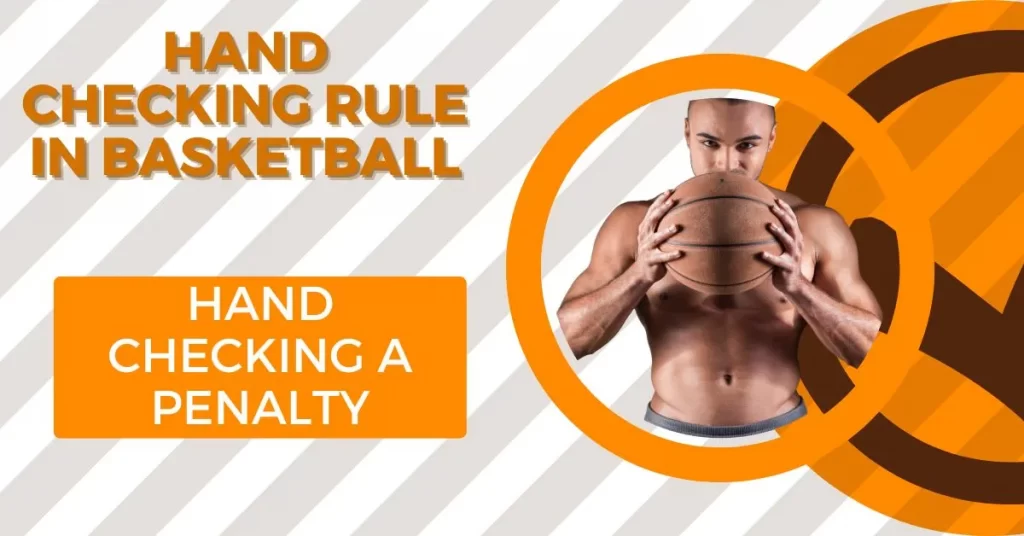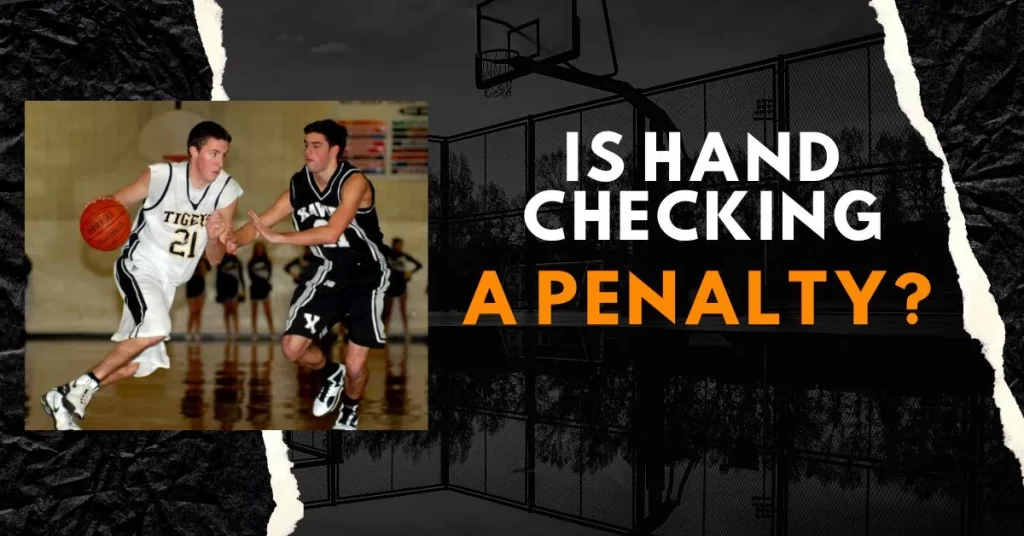Hand-checking in early basketball was one of the defensive strategies. Since the inception of basketball, the rules of basketball have been constantly changing, upgrading, and evolving. However, the eradication of the Hand-checking rule in 2004-05 changed the entire nature of basketball and came up with reformed principles. Without wasting time, let’s delve more into the disclosure of, what is the hand check rule in basketball. To find the retort for you.

What is a Hand Check in Basketball
Hand-checking in basketball refers to the hindrance by the defender in the way of the offense to impede their movement and play, as a result of their illegal and prohibited placement of hands/arms leading to a personal foul. The defender may momentarily touch the offense player anywhere on the court as long as it does not affect the player’s overall performance (in terms of speed, quickness, balance, rhythm, etc). However, the foul may lead to a ‘Dead ball’ resulting in an inbound pass for the offense and eventually free throws too.
The defender would play the hand-check on both, on-ball and off-ball offensive players, yet, it was mostly executed for the player with the ball possession, to intercept the passes and the score. The hand-check foul was considered to have occurred while satisfying either of the rules/criteria stated below.
- When a defender by their arms/hands forces and compels the offensive player to alter or control their movements.
- When a defender tries to restrict and limits the movements of the offender using their arms/hands.
- When a defender places their arms/hands to forcefully change the direction of running or moving of the offensive player.
Note to ponder, the similarity between the hand-check and the reach-in-foul. The reach-in foul includes a “one-hand” play defense by the defender with the idea of ‘repeatedly reaching’ close to the offensive player and stealing the ball, whereas, the hand check is executed by defending with “both” hands/arms.
Is Hand Checking a Penalty in High School Basketball?
Yes, hand checking is the penalty and not legal in high school basketball. Though the rules work differently than NBA and NCA in school basketball, However, a hand check is considered a foul and gets a penalty if observed by the players.
Since the individual high school teams have their own specific rules defined, it usually gets cumbersome to identify hand checks at the teamplay level, on the basis of the rules. However, the two organizations, The University Interscholastic League, (UIL in Texas) and SDHSAA (South Dakota High School Activities Association) formerly announced their to-check key points for hand-checking.

The University Interscholastic League stated the words: “The following acts constitute a foul when committed against a ball handler/dribbler: a. Placing two hands on the player. b. Placing an extended arm bar on the player. c. Placing and keeping the hand on the player. d. Contacting the player more than once with the same hand or alternating hands.“ Besides, the SDHSAA lists several rules to consider, which are mentioned below:
- Hand checking will be called if the defender dares to put or place his hand/arm for “too long” on the offensive player.
- Hand checking is said to occur when the defender tries to restrict the offense’s play by keeping “both of his hands” on the offensive player.
- The “recurrent and continual” placement of hands on the opponent also leads to hand-checking.
- The constant jabbing at the offensive player, which is usually rough contact with the player (instead of the ball) falls under hand checking.
- Hand checking is considered when the defender performs an illegal armbar against an opponent.
The SDHSAA highlights that the violation of the stated rules leads to unpenalized warnings however, the constant breach may be regarded as fouls and thus, consequences in penalties. In general, no matter how consistent the calls are, the ground verity is that the hand check is not allowed in high school basketball and brings the penalty with it if officiated by players.
Why Is Hand Checking a Penalty?
Yes. The two prime reasons that caused the hand check to fall under penalty criteria are More subjection of the players to injuries and Less scoring rate.
Basketball players nowadays tend to be more athletic, muscular, and stronger than before. The excessive belligerent and aggressive constant physical contact of players and the reprehensible acts like grabbing, pushing, and slapping used to outcomes in injuries and wounds. Thus to prohibit and lessen the damage, the hand check rule was declared illegal and comes with a penalty if observed.
Besides, the defense with the powerful strategy of hand check used to out-turn in less gameplay and progressive ability of the offense overall, which often made the game uninteresting. Another consequence of persistent stoppages of the gameplay used to cause fewer points for the offense and its types. Therefore, the more passive and less physical approach for the defense was introduced in the form of a hand-check penalty benefitting the offense.
Is there a penalty for Hand Checking? Calling the Penalty for Hand Checking:
The hand check is deemed as a personal foul, which is a foul personally committed by a player of the team and has a penalty when observed. The “penalty” refers to the awarded free throws to the offense as the effect of hand checks by a defensive player.
In NBA, the players are favored with five personal fouls per quarter before getting a penalty and six before being automatically disqualified from the game. In NCAA and high schools, a total of five personal fouls are granted before being automatically disqualified.
Automatic disqualifying of the player is made on the basis of exceeding the pre-defined number of personal fouls made(depending upon the league criteria), which results in “tossed out” of the player from the game and the return of the player solely depends upon the referee’s decision.
What is the Penalty of Hand Check NBA? NBA Hand Checking Rule:
The penalty in NBA for hand-checking is the same as that of the NCAA. Because of the fact that hand check impact on the score and the overall gameplay in the NBA was more significant than in other league levels, the NBA to holds a strict penalty for a hand check.
The overall offense score was recorded falling immensely in descending numbers as an outcome of relatively prominent excessive physicality between the players, to play and oppose the defense hence it was then decided to determine the hand check as a penalty if the defensive players were found to impede, restrict or divert the movement of the offense’s play by using both of their hands.
Since the hand check has been marked as a personal foul and the player may “cast aside” if appear to be observing exceeding the specified limit of “five allowed fouls”, the overall scoring rate of offense in today’s basketball play has increased enormously in comparison than usual. The teams nowadays tend to score over 100 points whether they win or lose, merely as an effect of the restricted hand-check rule.
Is Hand Checking a Penalty in the NCAA?
Yes, just like other leagues in the NCAA, hand-checking is considered a penalty and is illegal. Before the 2013 NCAA basketball season, the rule was revised by the NCAA and modified the hand check into the hands-off rule. The NCAA rule remarking: “Anytime the defender places both of his hands on the offensive player to hinder, interfere and limit the movement or flow of the offense, a personal foul is said to occur.”
The idea of the modified rule was to turn the tables in favor of the offense and in hopes of an increase in offense scoring ability. However, the adaptation wasn’t worthwhile and unexpectedly panned out in more extended games, supplemental free throws, and greater degree fouls. But the teams have adapted and the hands-off hand-checking rule is now just another part of the game.
When Did Hand Checking Become a Penalty in the NBA? Why it was banned in the NBA?
Hand check was officially considered banned and appeared as a penalty in the season 2004-05 in the NBA. In addition, the rule also quoted regarding: “scrapping of illegal defense, clarified the three-second defense rule and explained 10-8 second shift before a violation call.” The prime purpose to ban hand checks was an increase offensive score output and less physicality preventing injuries.
In the past, the hand check was the fundamental defensive strategy to control the offense and no penalties were imposed unless encountered extreme situations of bodily contact. Up till 2004, it was practiced as a primary way of defense and no hard and fast rules were made till then. However, in 2004, the real evolution of the rule was made which shifted and transformed the basics of basketball completely.
The banning of hand checking however molded the NBA idea of more movement tendency, and more play. As the earlier defensive-minded games started droving low-viewer interest because of passive mobility, motion, and progress in the goals and the score. Hence the rule was instigated, to increase the offensive maneuver gameplay. Not only that, but it also enforced grasp the command over other defensive skills like shooting, spacing the floor, and keeping defenses honest.
The effective results of hand-check banning can be seen on today’s score cards of the offenses. The average statistics are considerably observed higher since it was first recorded in 1973-74. Besides, the reason for the hand check ban was to devise less physical playfulness and personal touches in order to thwart and prevent the players from injuries, damages, and harm of any kind.
Wrapping Up: How Hand Check Changed the NBA
The hand check rule is one of the original 13 rules of basketball that was formed and stated by Dr.Naismith in 1981 inside Springfield College walls. The changeover of the hand check rule has evolved NBA basketball into completely distinct epochs.
Along with the transformation of other rules, the hand check adaptation has changed the nature of (NBA) basketball entirely. The new approach certainly has paved the way for the more potent offensive play, more free-movement tendency, and higher scoring ground, and has made the game inevitably exciting and flexible to play. Hence, not wrong to say, it’s a charm and a bonus beneficiary to offense.
Moreover, the NBA expects its players to seek upgraded ways of defense as a result of hand-check abolition to meet the advanced perimeters and tactics of defense strategies. Hence, the players now are trained for the NBA with the principles to execute “No hand-check” in their defensive guide.